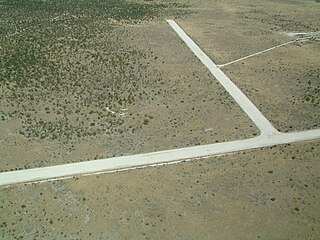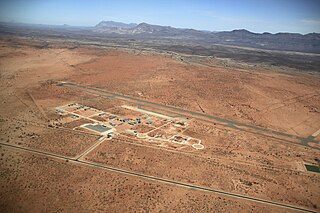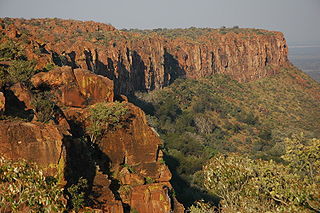
The Otjihaenamparero dinosaur tracks are a set of different fossil tracks located at the Otjihaenamparero farmstead, 23 kilometres (14 mi) east of the small town of Kalkfeld in the Otjozondjupa Region in central Namibia. The tracks were first reported as dinosaur imprints in 1925 and the site has in 1951 been declared a national monument.
Tetrapodium is an ichnogenus of fossil footprints found in the Etjo Sandstone and Omingonde Formations of Namibia. The Etjo Sandstone fossils were initially identified as rounded, featureless depressions presumed to have been made by a quadrupedal animal, but more recent examination in 2016 could not identify such tracks and concluded they are most likely non-biogenic features of the rock surface.

The Etjo Sandstone is an Early Jurassic geologic formation in northern Namibia. The formation overlies the Omingonde Formation in the Waterberg Basin and the Doros and Gai-As Formations in the Huab Basin and has a total thickness of 140 metres (460 ft). Fossil theropod tracks of Prosauropoda indet., Theropoda indet., Tetrapodium elmenhorsti, Saurichnium anserinum, S. damarense, S. parallelum and S. tetractis have been reported from the formation, deposited in an aeolian environment.

Halali Airport is an airport serving the resort of Halali, in the Oshikoto Region of Namibia. The resort is near some of the waterholes of the Etosha National Park, and has elevated viewing platforms for observing native wildlife like elephants, rhinoceros, and leopards.
Kamanjab Airport is an airport serving the village of Kamanjab in the Kunene Region of Namibia. The runways are 11 kilometres (6.8 mi) north of the settlement.

Karibib Air Force Base is an air base near the central Namibian town of Karibib. Since 2016, the headquarters of the Namibian Air Force are located here. Air Force Command had previously been at the Grootfontein Air Force Base.
Karasburg Airport is an airport serving the town of Karasburg in ǁKaras Region, Namibia. The runways are 1 kilometre (0.62 mi) southwest of the town.
Mariental Airport is an airport serving the town of Mariental, in the Hardap Region of Namibia.

Mokuti Lodge Airport is an airport serving Mokuti Lodge resort and the Etosha National Park in Namibia.
Namutoni Airport is an airport serving Namutoni and the Etosha National Park in Namibia. Namutoni is an entrance gate to the park.
Okaukuejo Airport is an airport in the Oshana Region of Namibia, serving the Etosha National Park and its administrative center, Okaukuejo. The runways are 3 kilometres (1.9 mi) north of the village.
Omega Airport is a former military airport serving the village of Omega in the Kavango East Region of Namibia.
Opuwo Airport is an airport serving Opuwo, Namibia.
Oshakati Airport was an airport serving Oshakati in the Oshana Region of Namibia.
Otjiwarongo Airport is an airport serving Otjiwarongo, in the Otjozondjupa Region of Namibia.
Outjo Airport is an airport serving Outjo, in the Kunene Region of Namibia.
Ruacana Airport is an airport serving Ruacana and the Ruacana hydroelectric power station in the Omusati Region of Namibia.

The Omingonde Formation is an Early to Middle Triassic geologic formation, part of the Karoo Supergroup, in the western Otjozondjupa Region and northeastern Erongo Region of north-central Namibia. The formation has a maximum thickness of about 600 metres (2,000 ft) and comprises sandstones, shales, siltstones and conglomerates, was deposited in a fluvial environment, alternating between a meandering and braided river setting.

Etjoia is an extinct genus of traversodontid cynodonts that lived during the Middle Triassic or Late Triassic period in southern Africa. This medium-sized omnivorous cynognathian provides important information on the dental evolution of early diverging gomphodonts and traversodontids.







